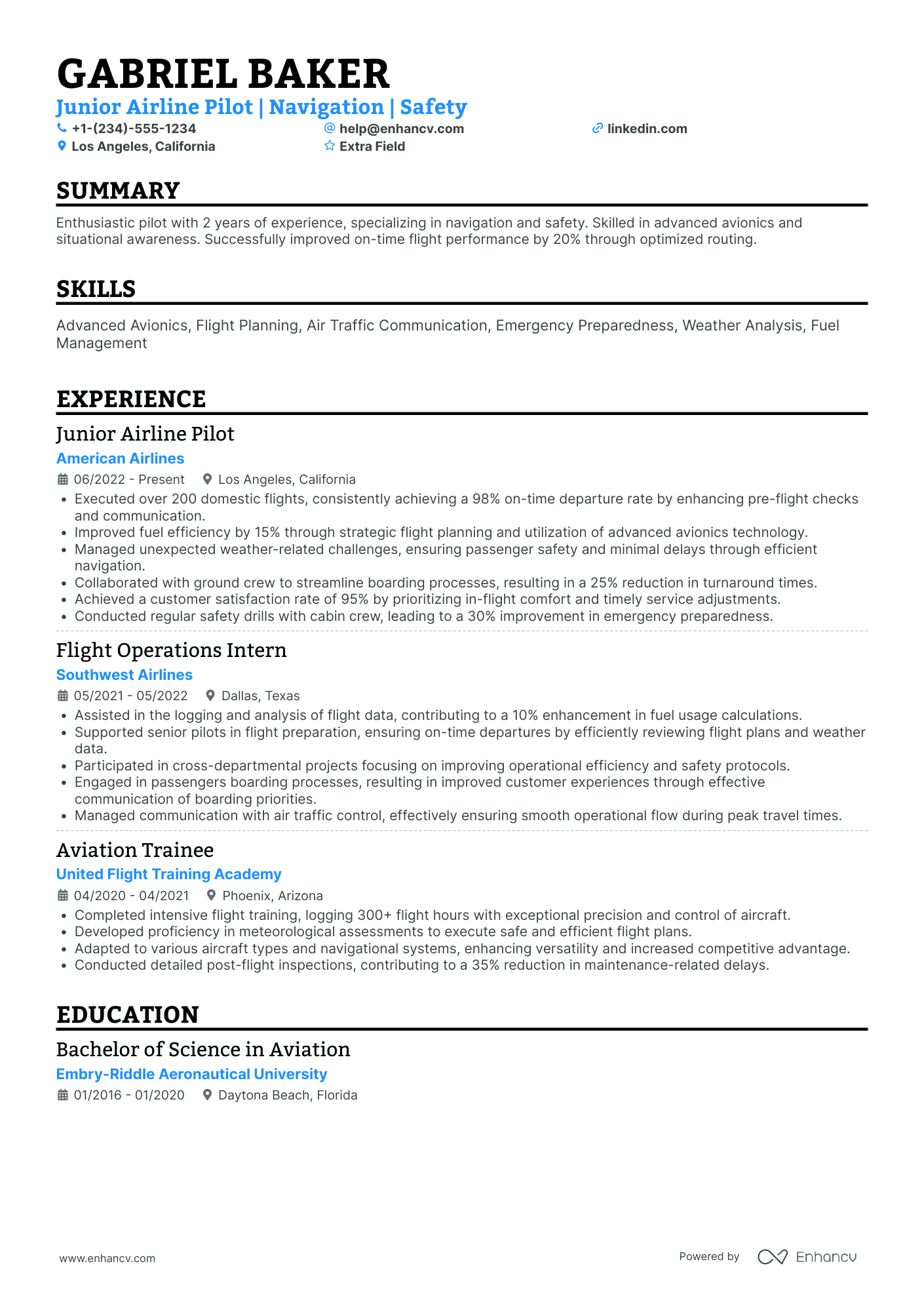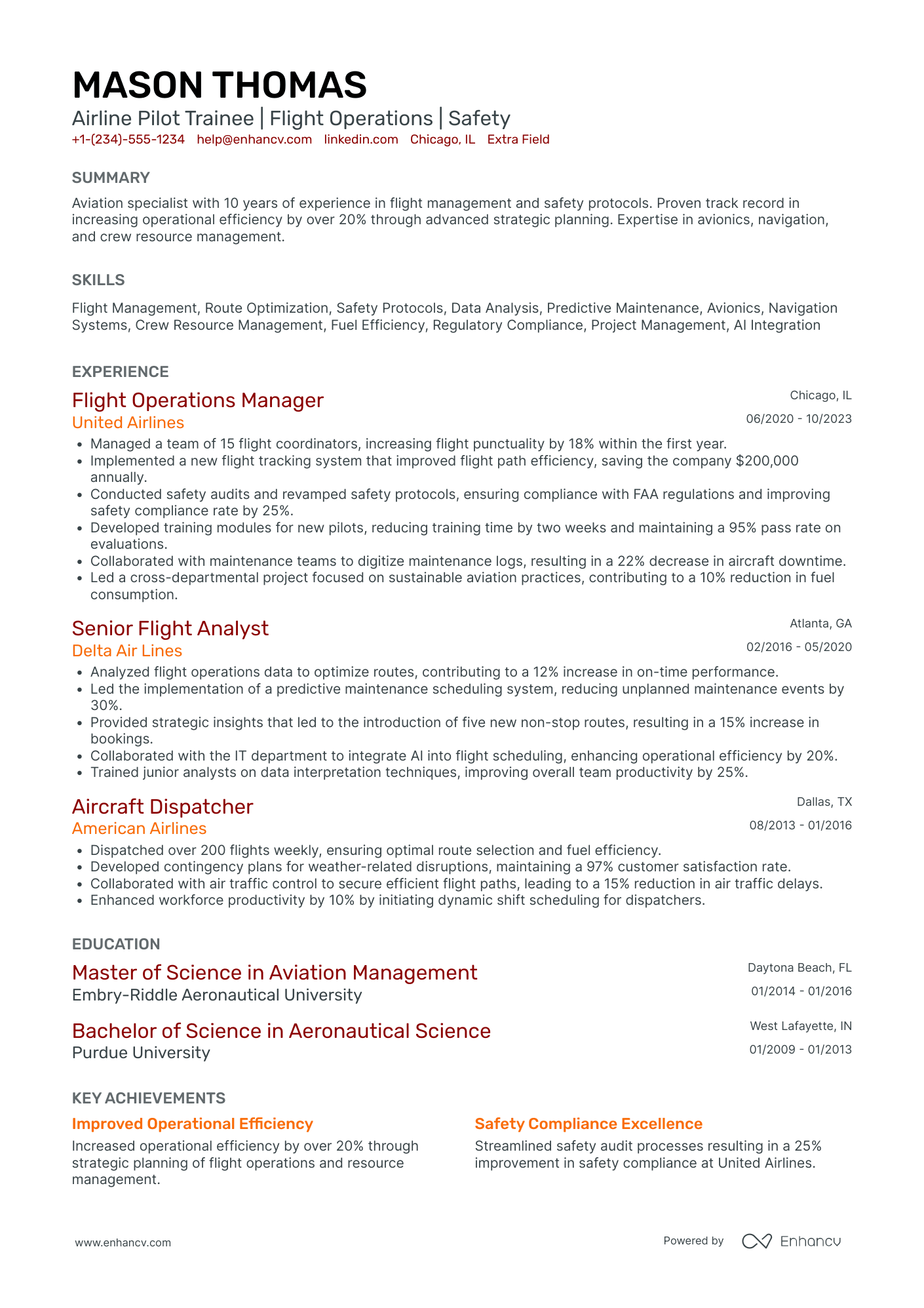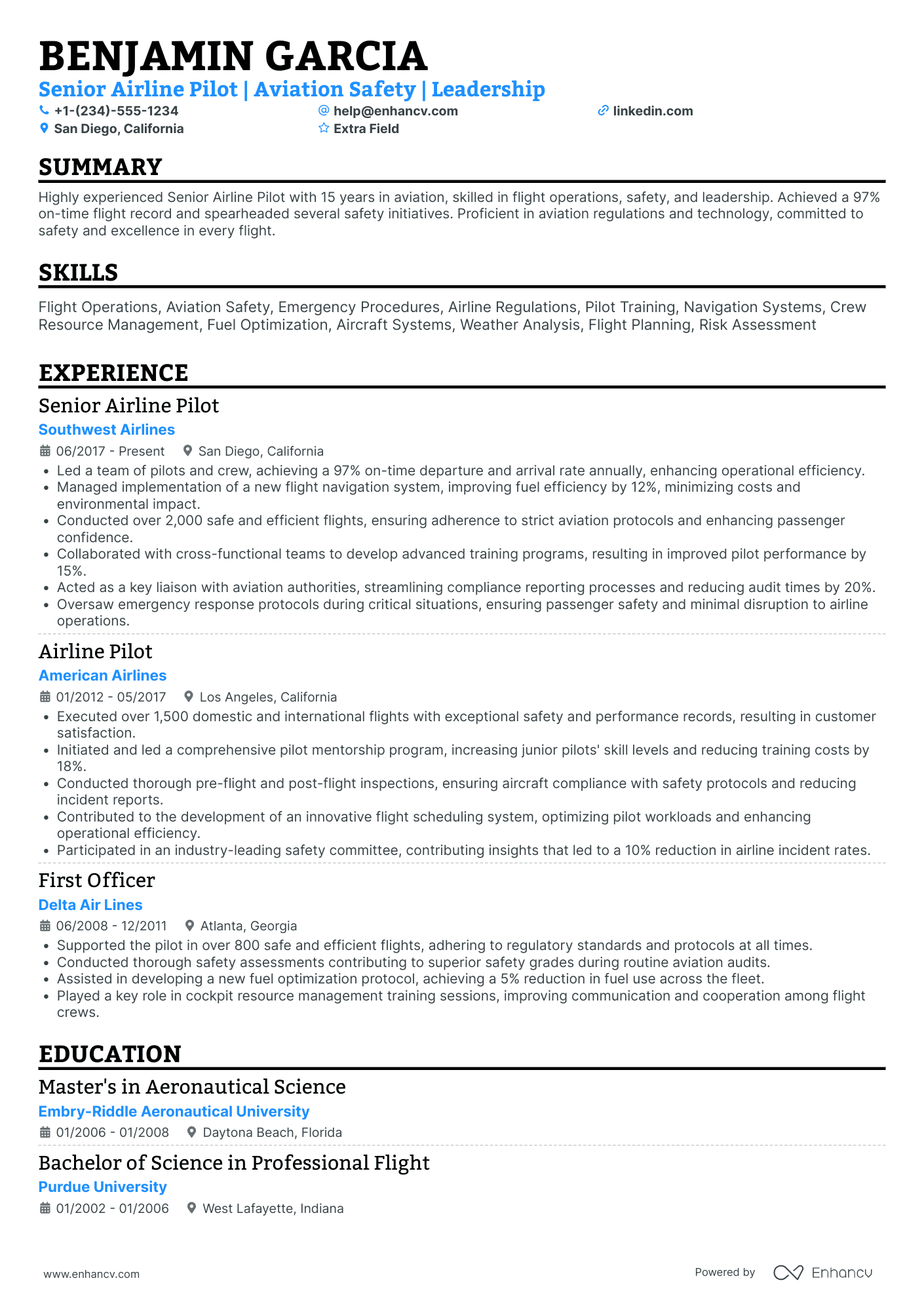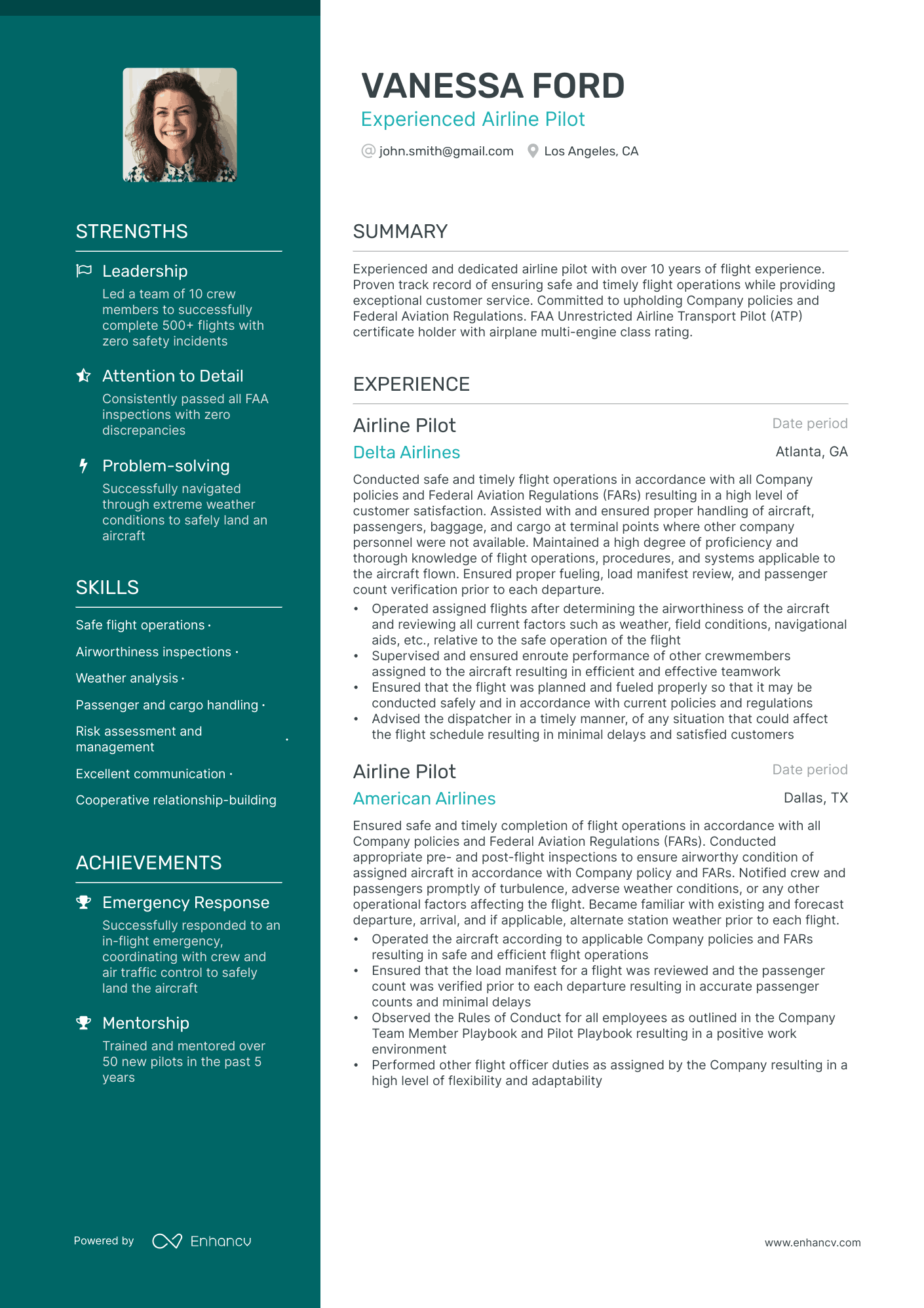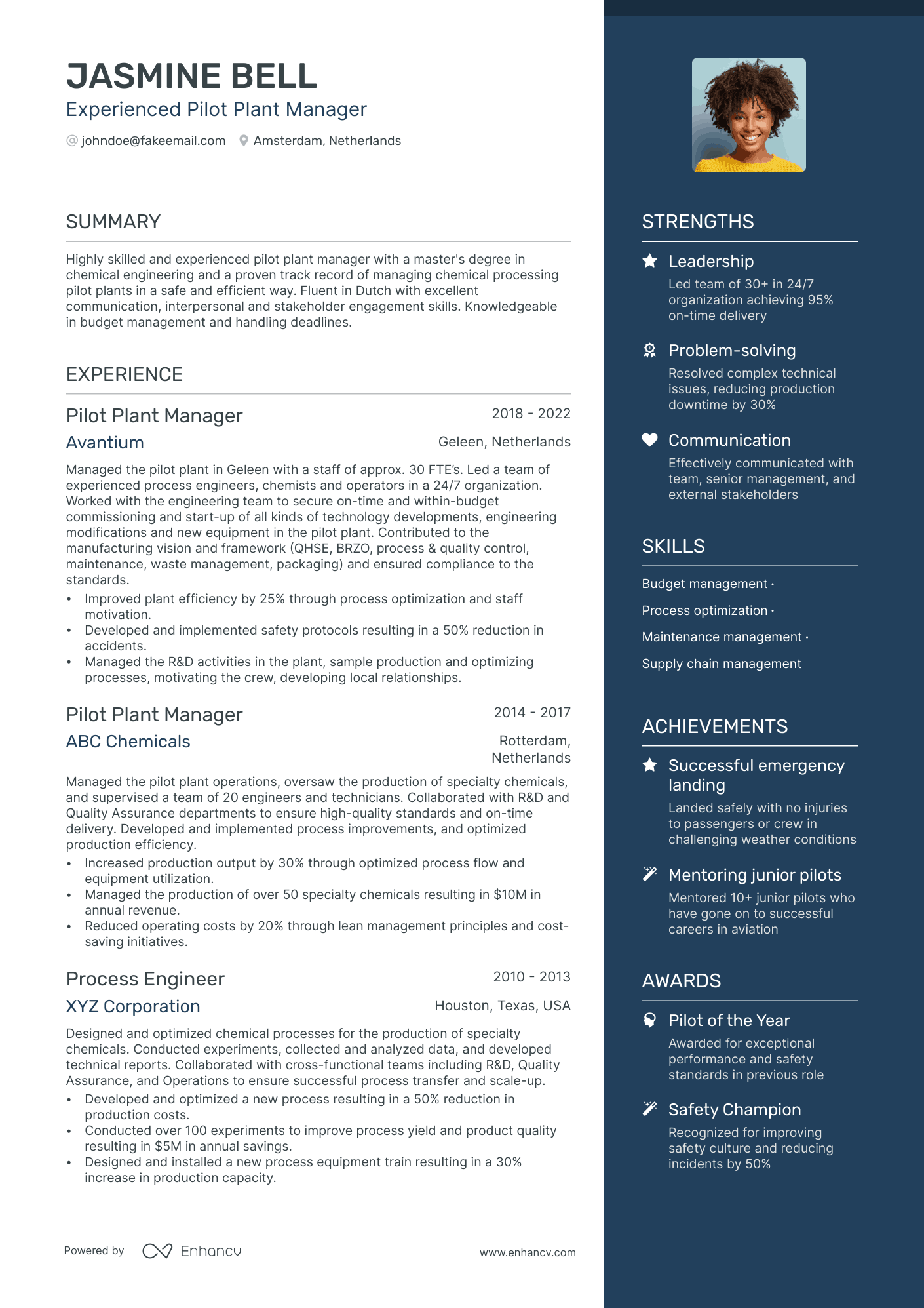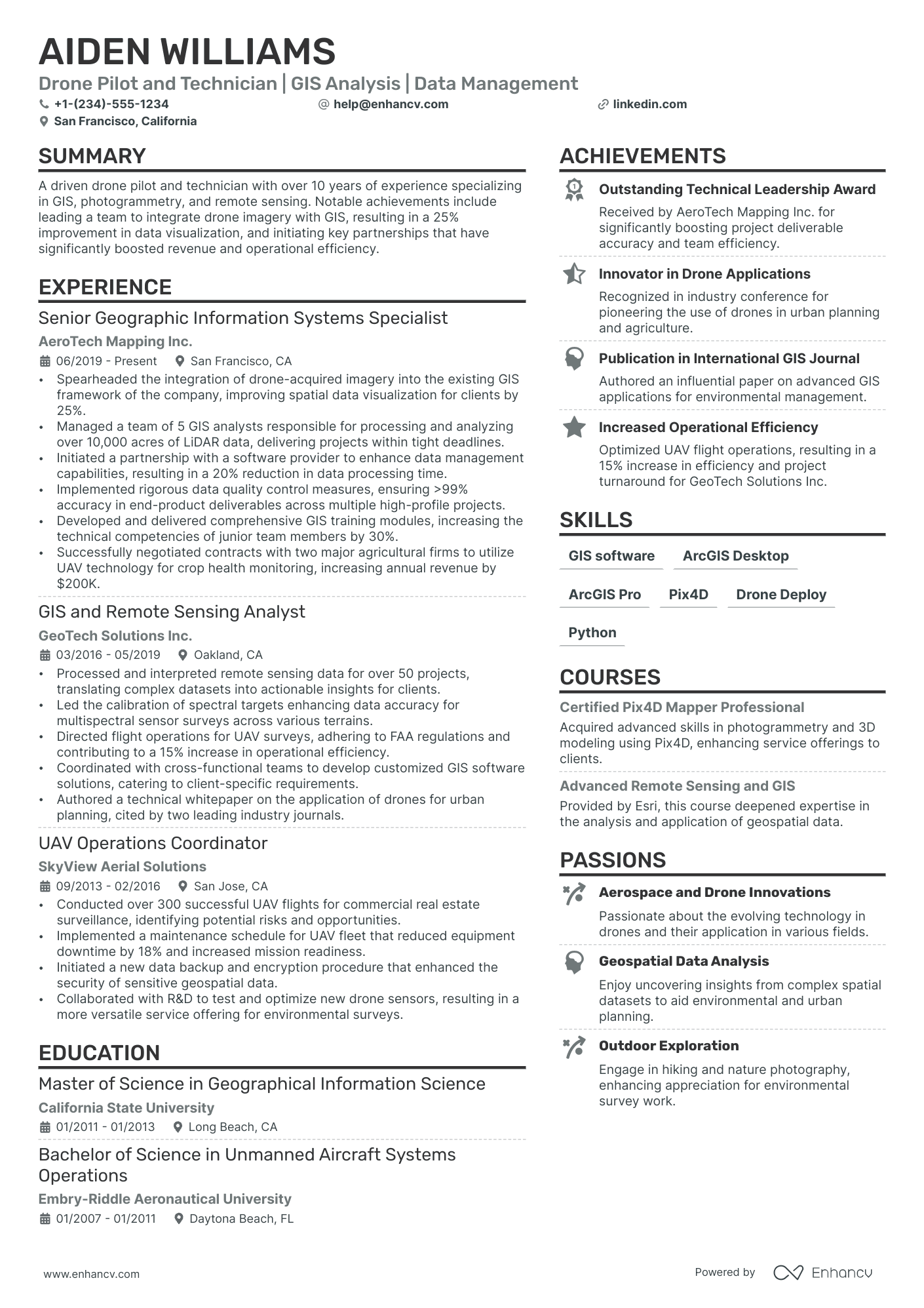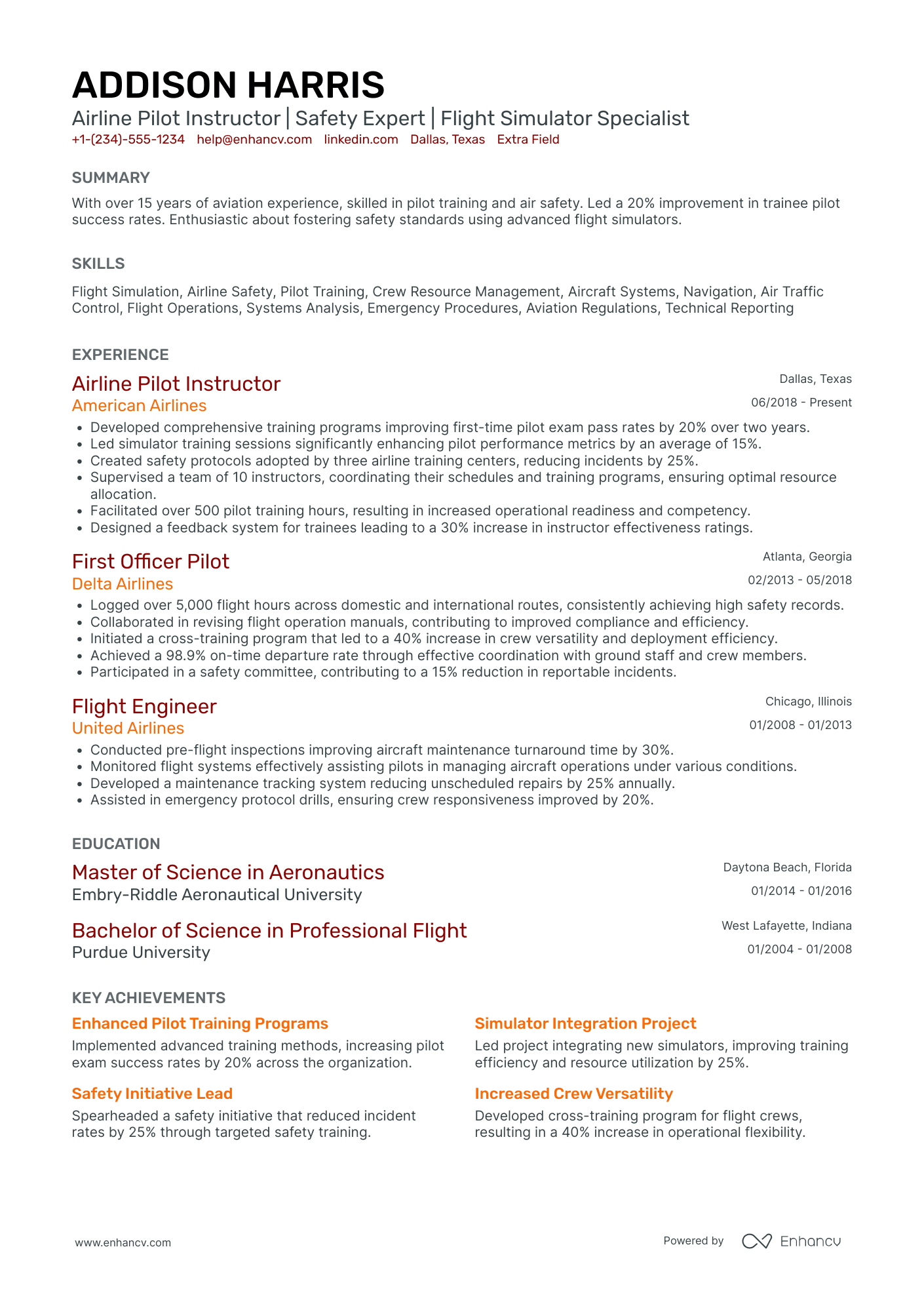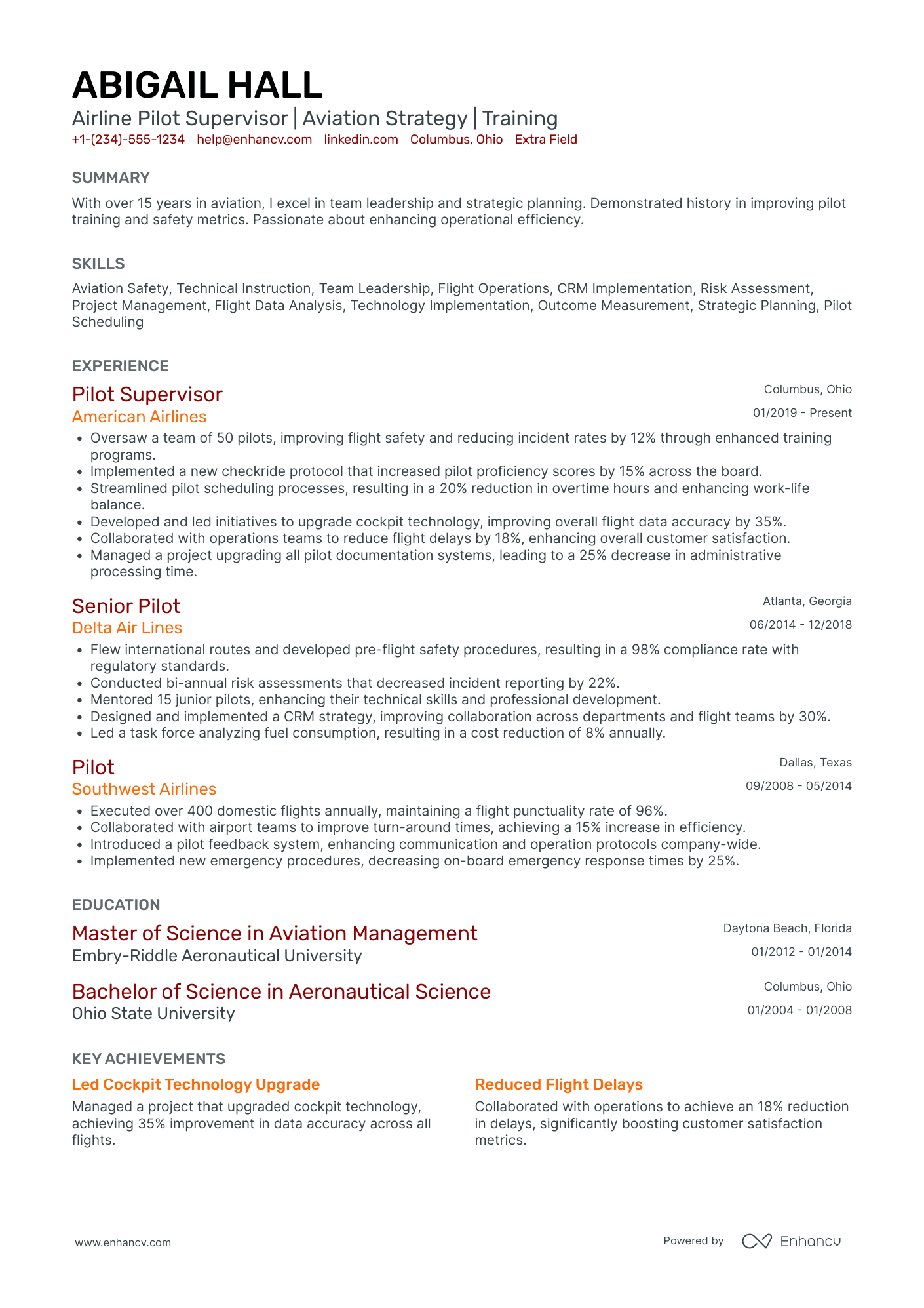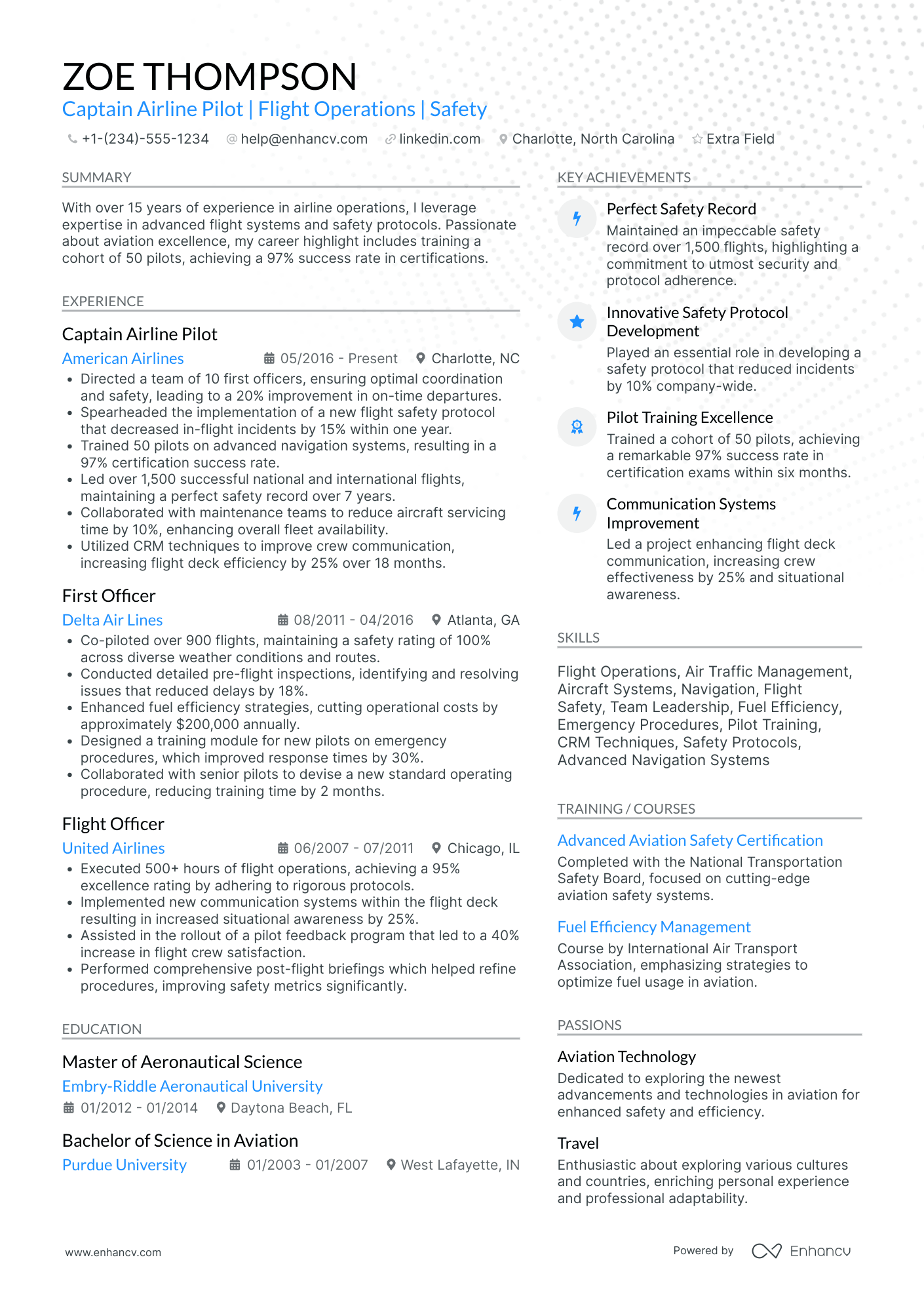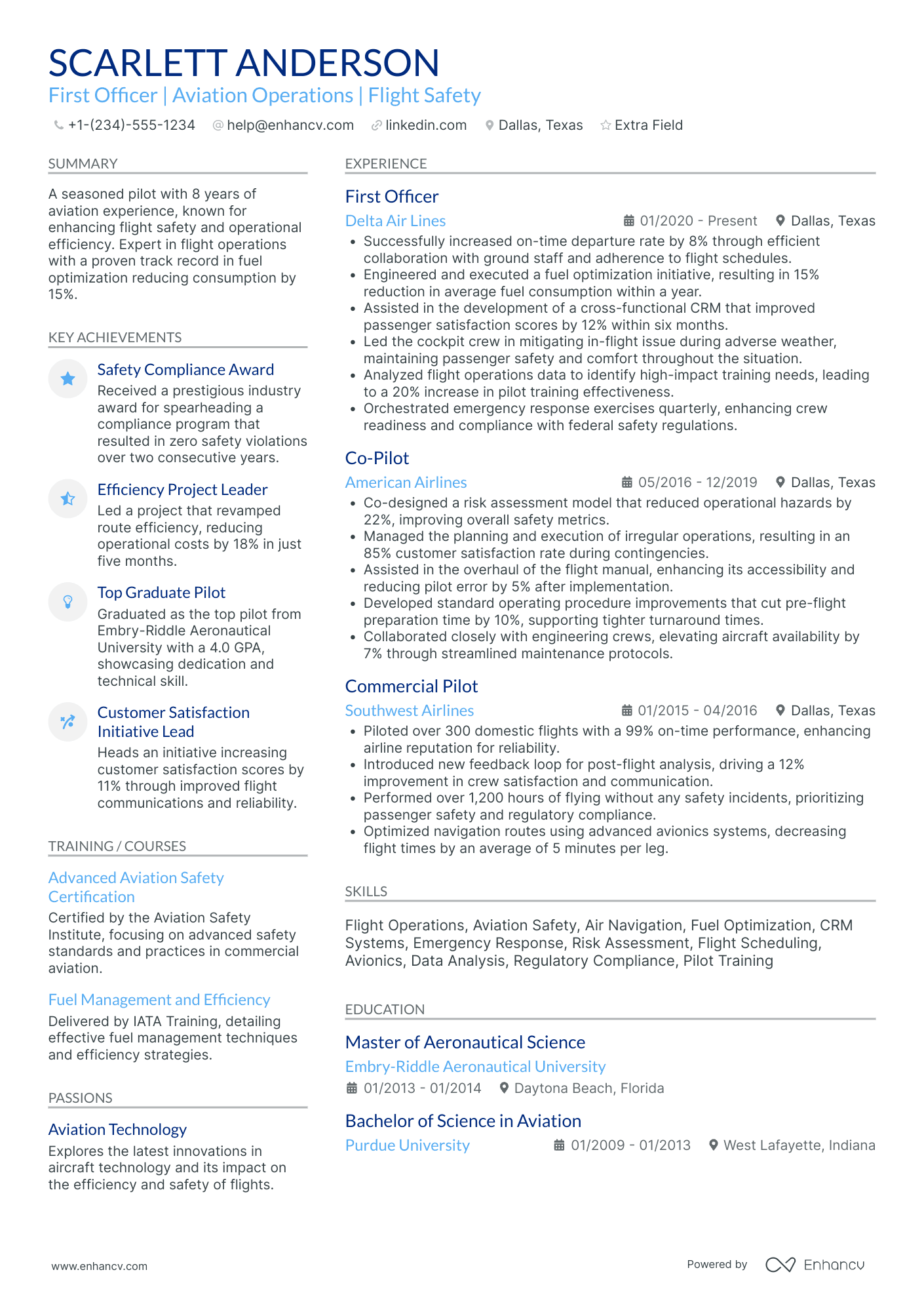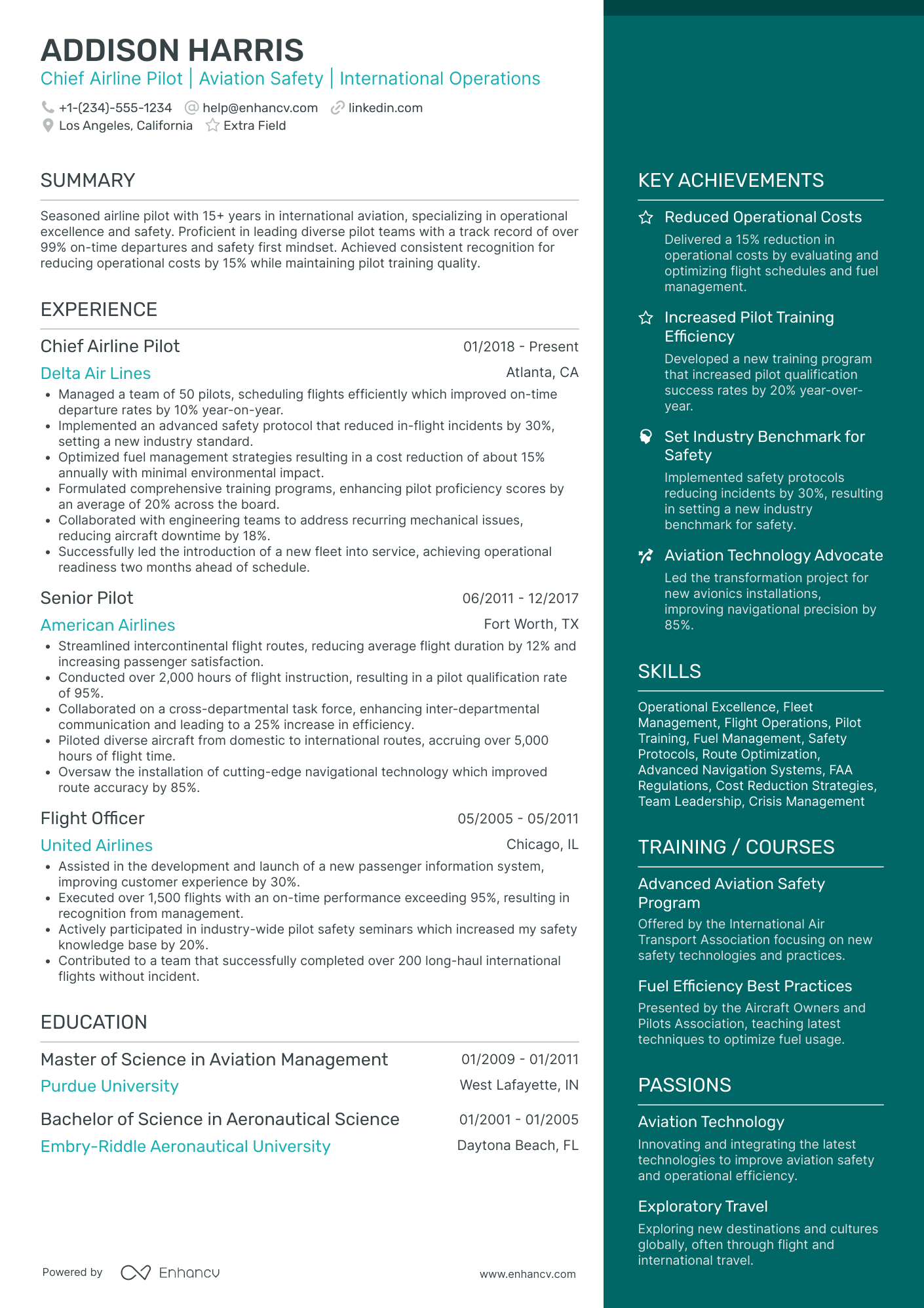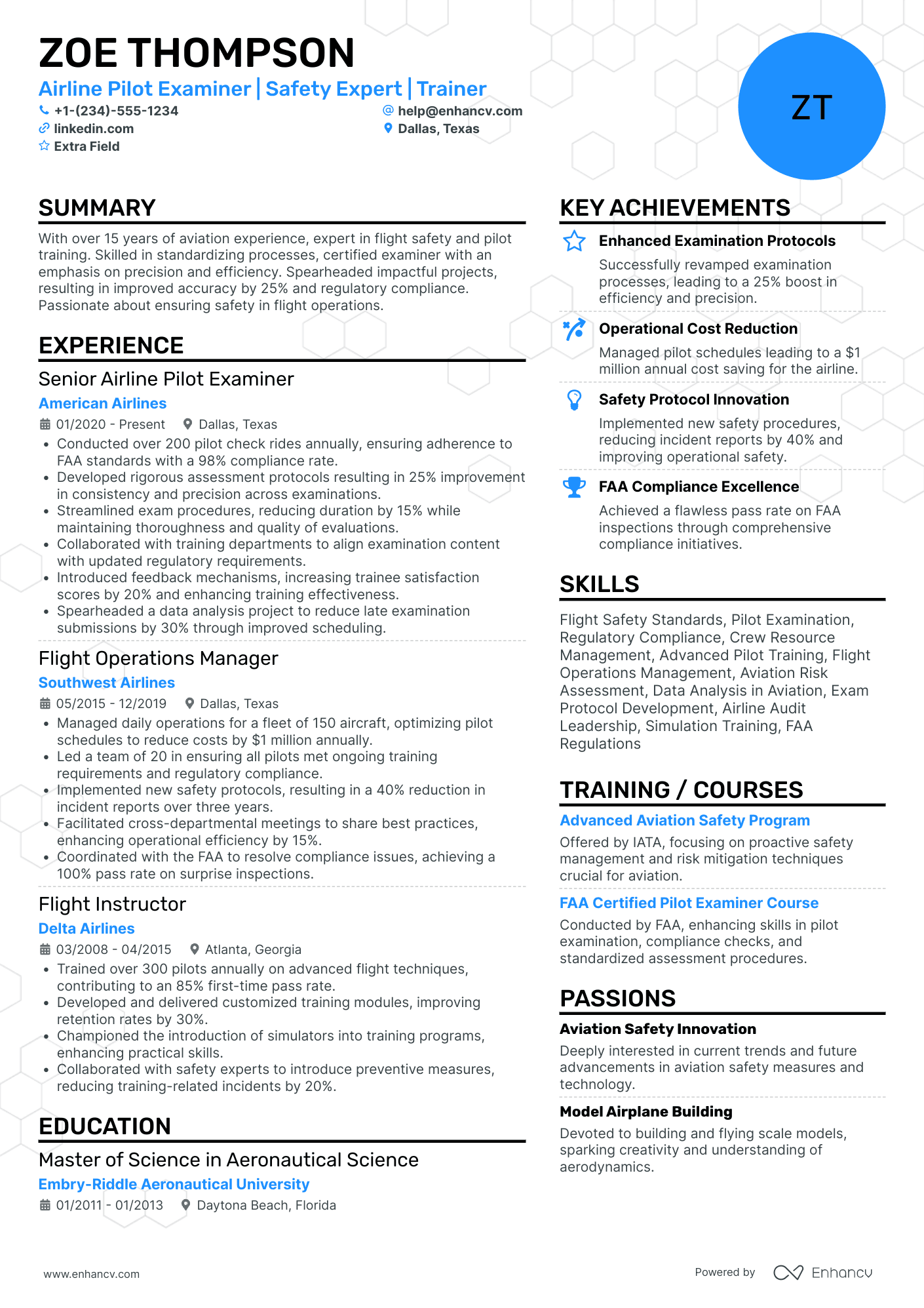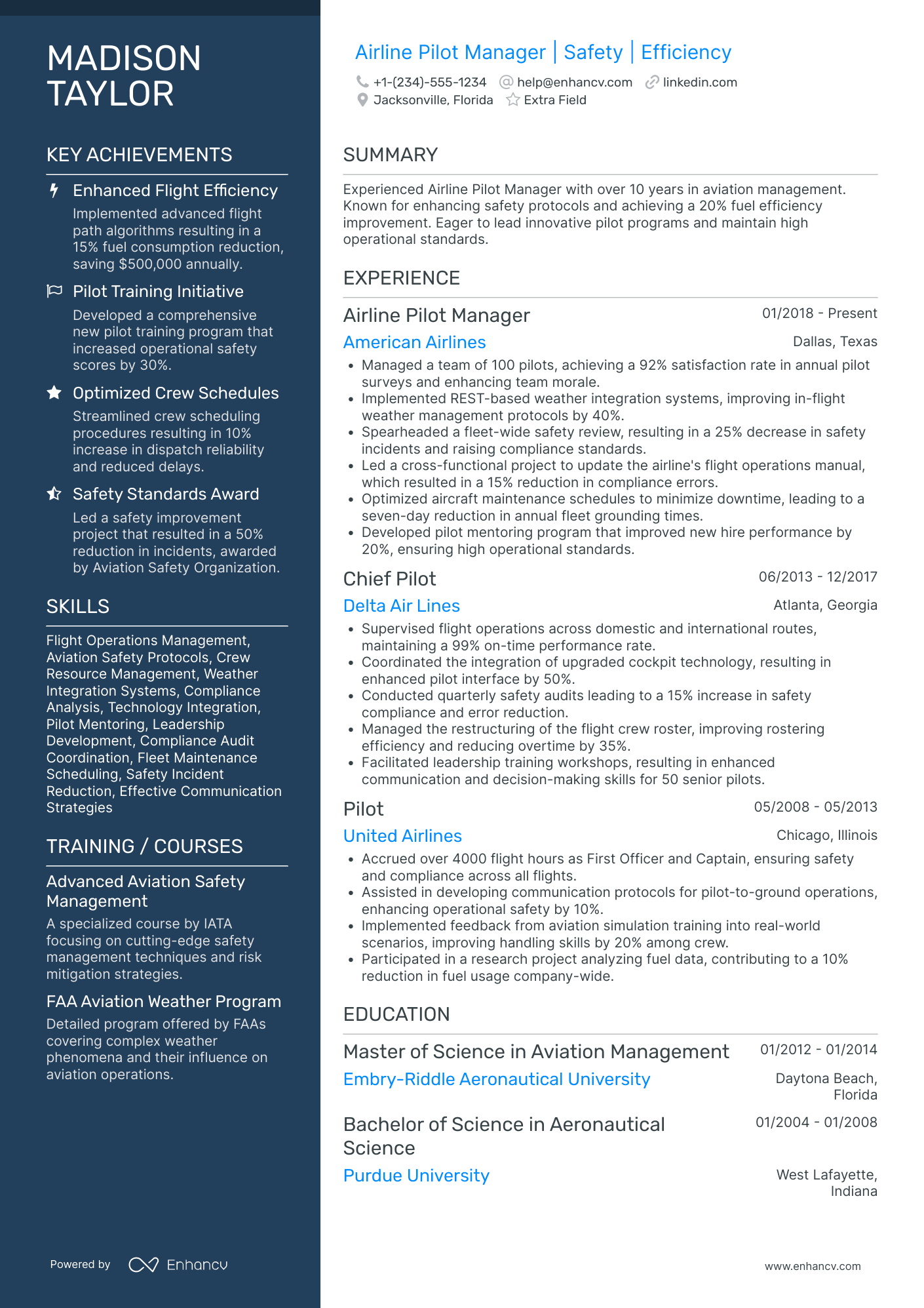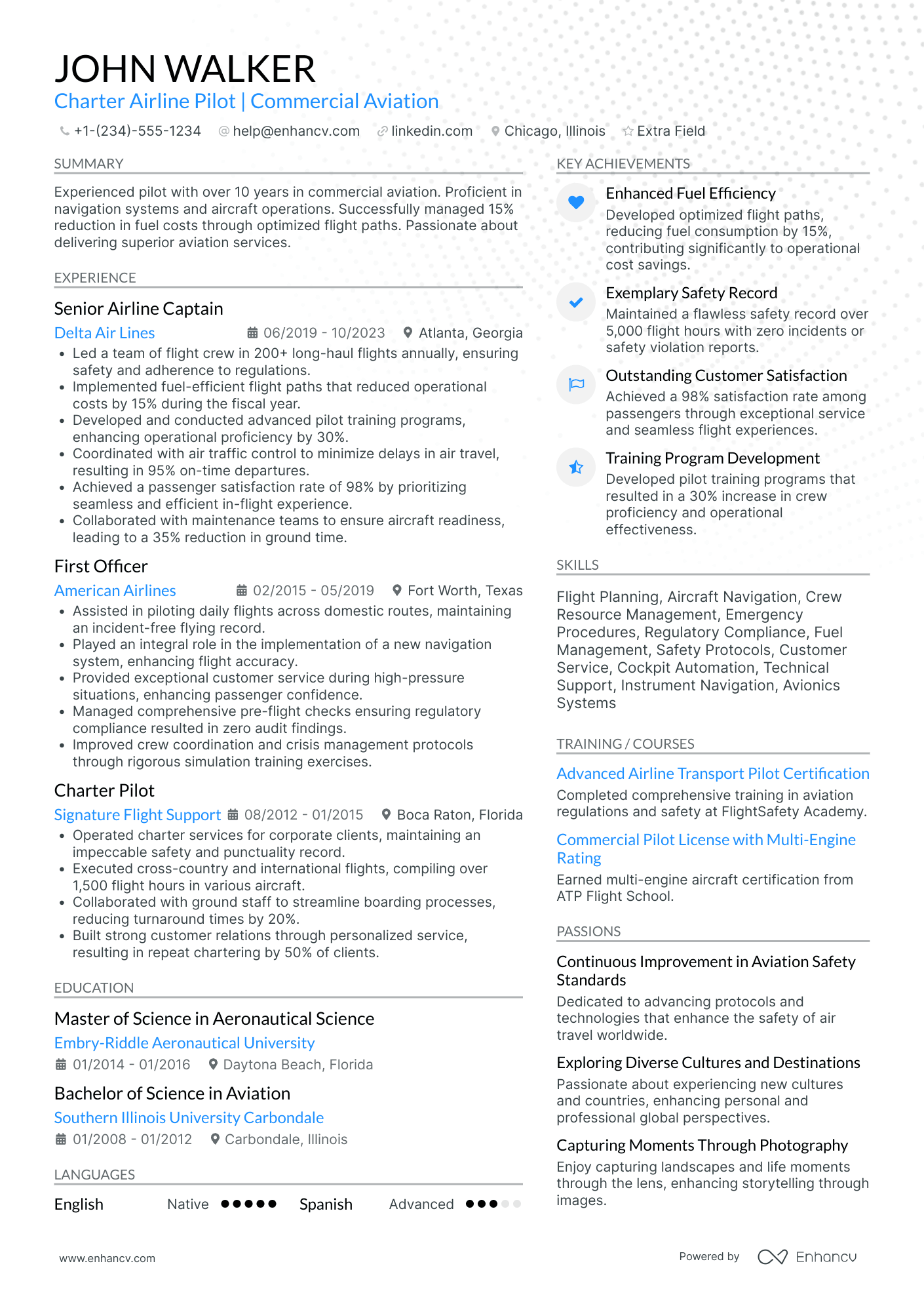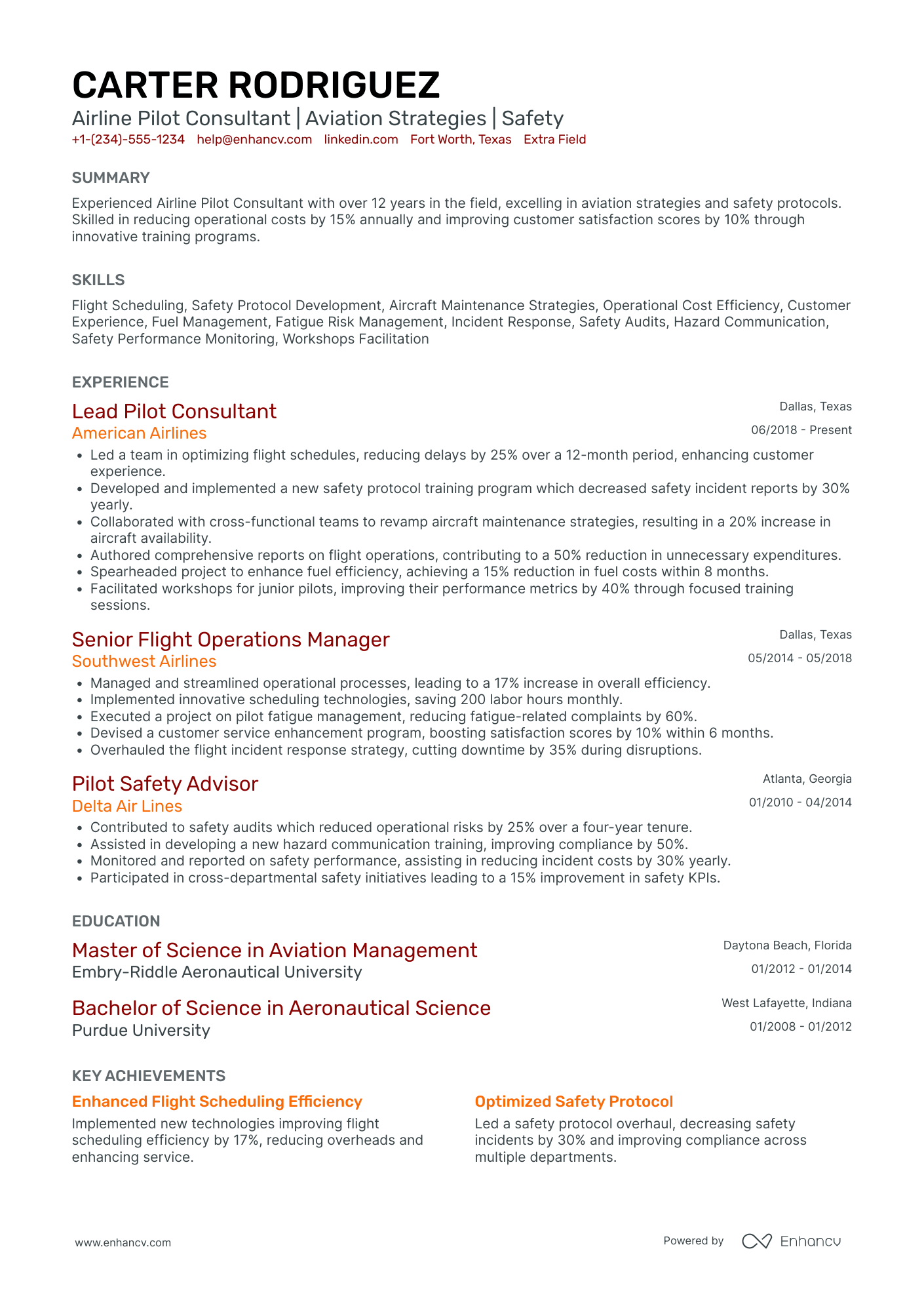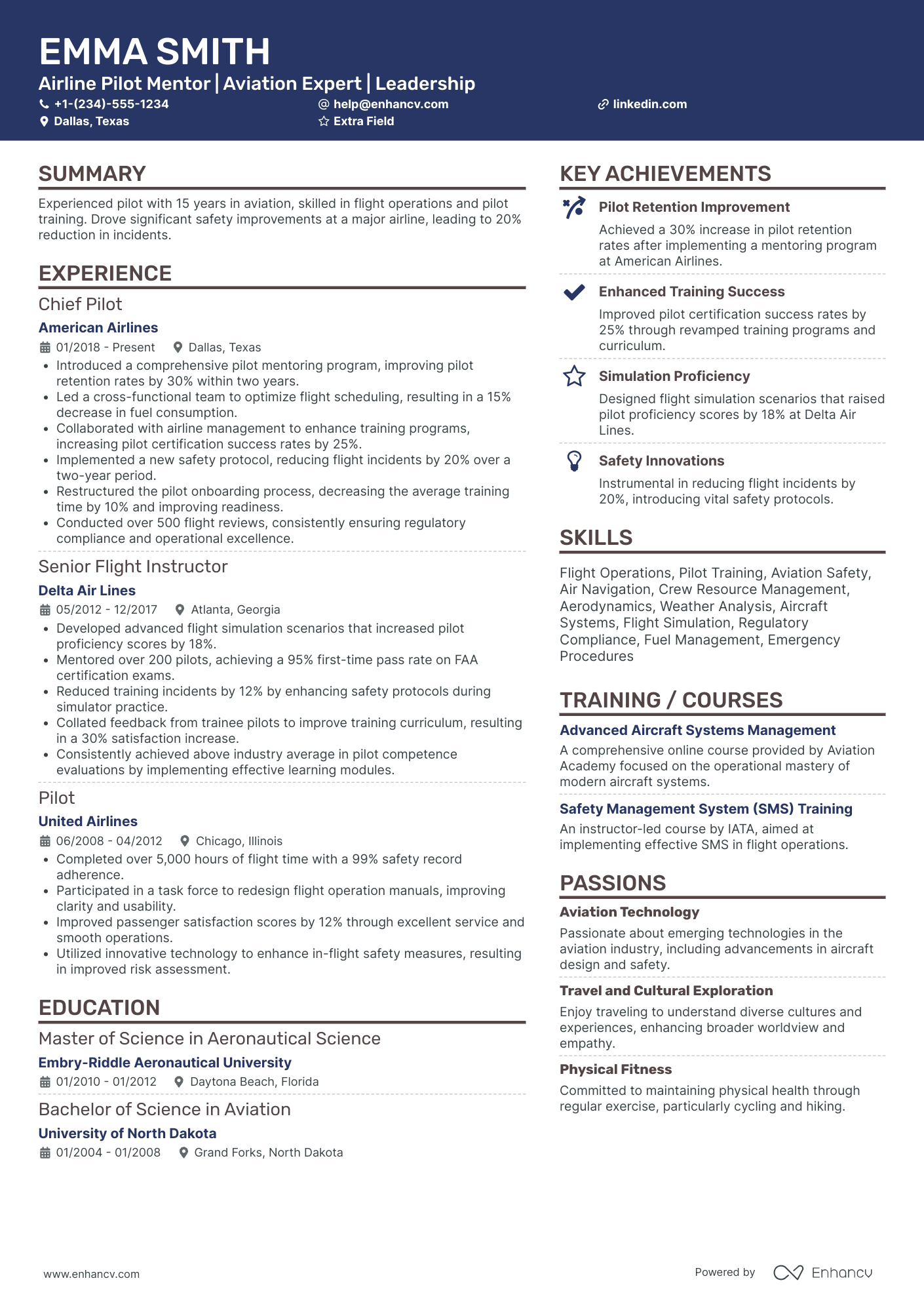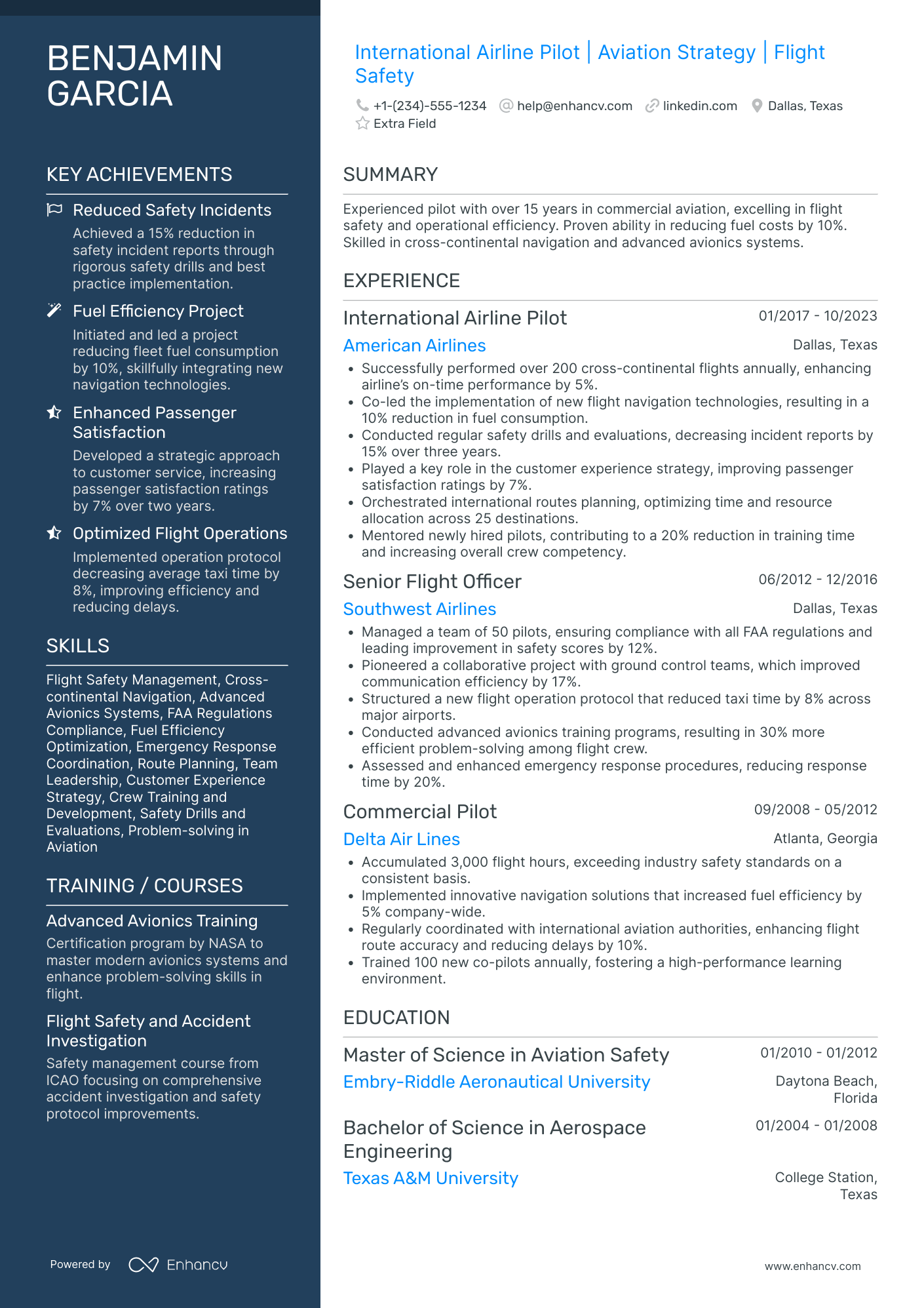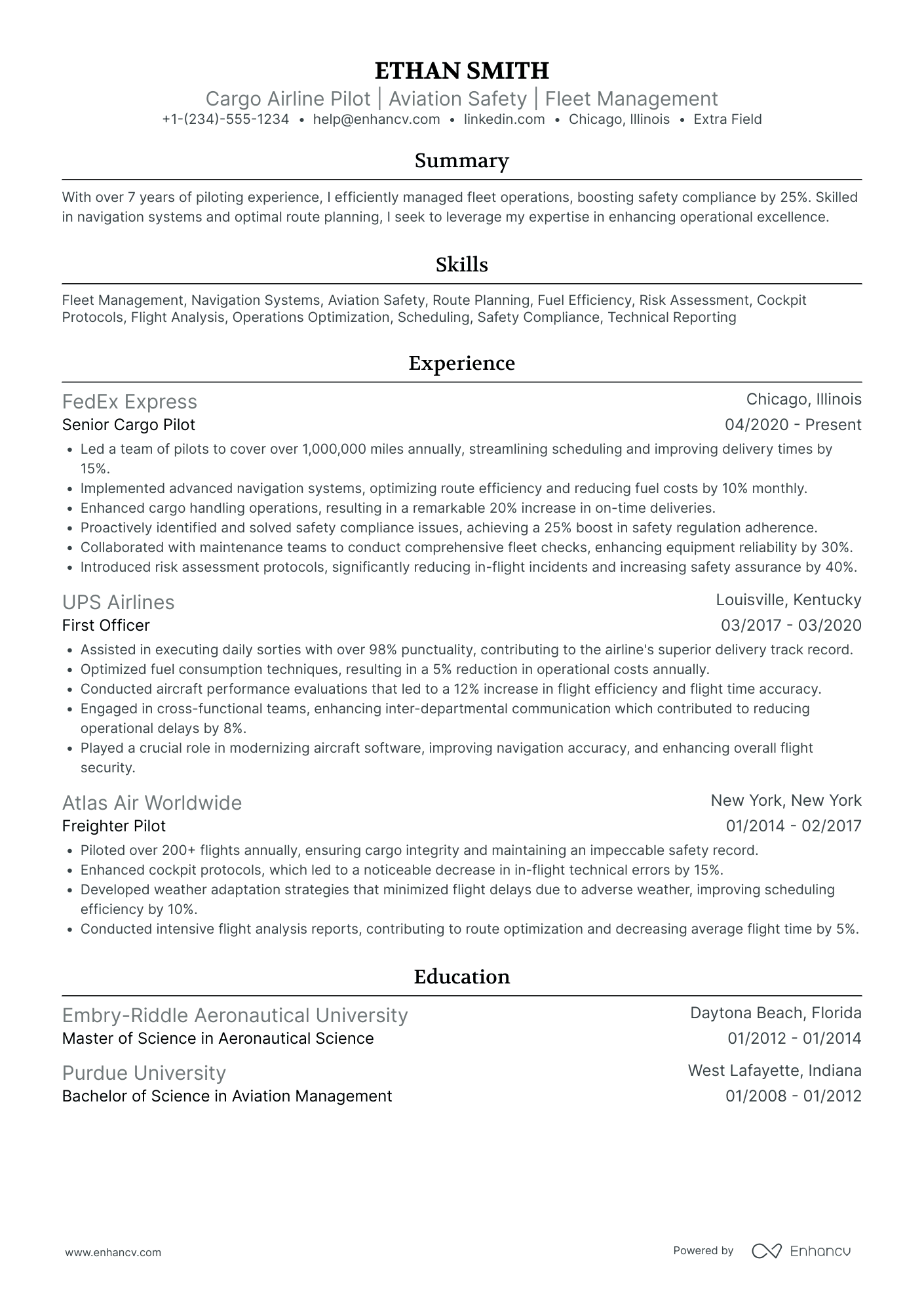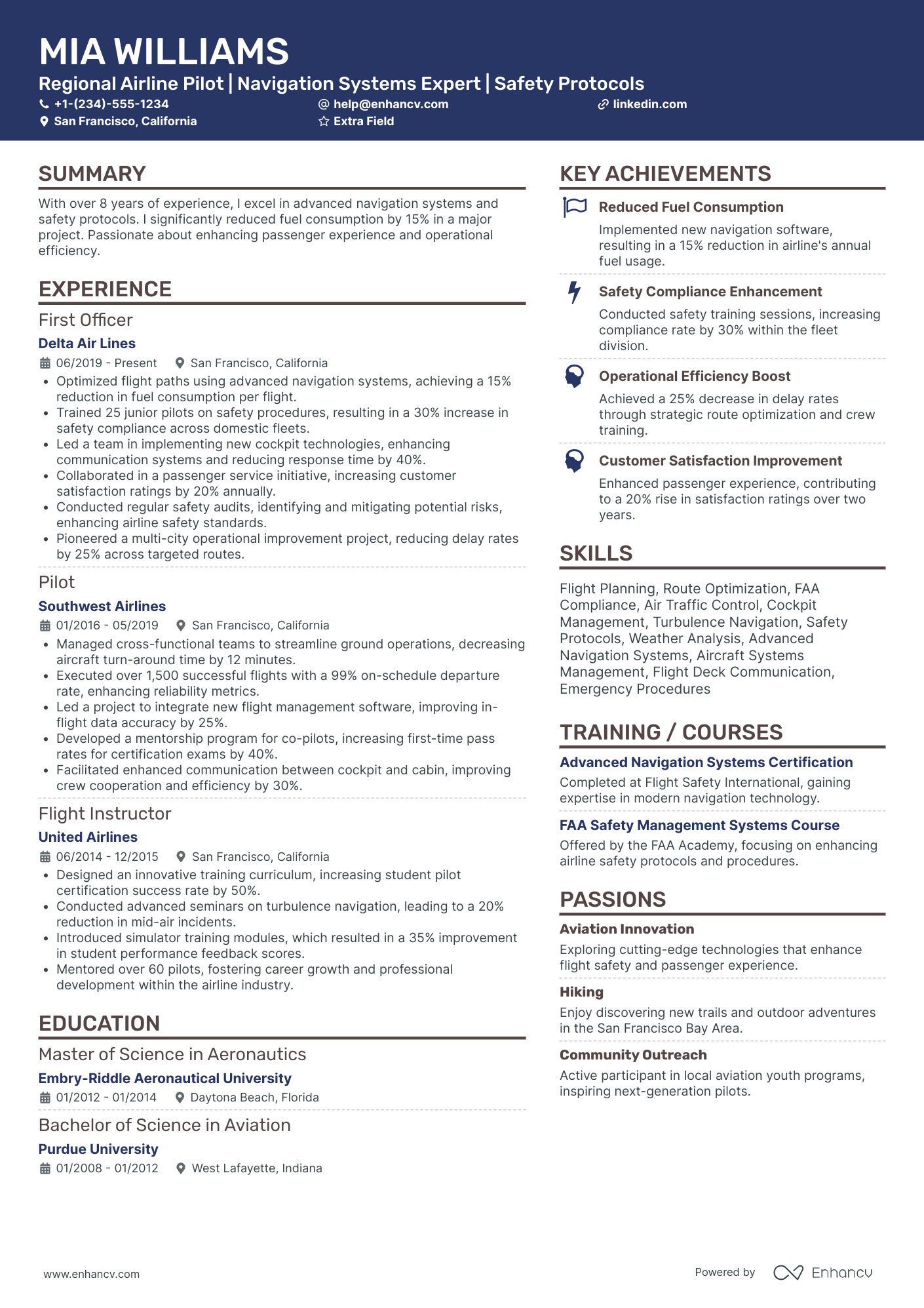Despite the cyclical and unstable nature of the airline industry in recent years, mostly due to COVID-19, job opportunities for pilots remain appealing. Overall employment of airline and commercial pilots is projected to grow by 4% from 2022 to 2032.
This means there’s steady demand in the field. In this competitive environment, your pilot resume needs to be as organized and detailed as a flight schedule.
We'll guide you every step of the way, so by the end, you'll have a pilot's resume that shows off your strengths and makes a great impression. Take a look at what's ahead.
Key takeaways
- The reverse-chronological format illustrates your growth and advancement as a pilot.
- A well-organized design with soft colors and an attractive font can make your pilot resume stand out.
- Focus on your experience section by highlighting quantifiable successes and clear results to draw the attention of hiring managers.
- Leverage data to underscore the impact of your contributions as a pilot.
- Add a section dedicated to your technical aviation expertise and subtly integrate your soft skills throughout the resume.
- A relevant educational foundation in aviation is important and highly regarded.
Let's take a closer look at an example that demonstrates these key points.
Pilot resume sample
This pilot resume template will save you time and help you make a strong first impression.
Liam Johnson
pilot
liam.johnson@email.com | LinkedIn | Phoenix, AZ
Summary
Experienced and adaptable pilot with over 8 years of flight experience, proficient in operating various aircraft types. Skilled in both domestic and international operations, with extensive knowledge of FAA regulations and a dedication to providing exceptional service to passengers. Ready to contribute to NetJets with a strong commitment to safety and customer satisfaction.
Experience
Senior pilot
American Airlines, Phoenix, AZ
June 2026 – Present
- Operated various aircraft on international and domestic routes, ensuring safe and timely flights.
- Conducted pre-flight inspections and coordinated with ground crews for smooth operations.
- Trained and mentored junior pilots, enhancing their skills and performance.
First Officer
Southwest Airlines, Phoenix, AZ
January 2017 – May 2026
- Assisted the captain in flight operations and navigational duties.
- Managed in-flight communications and monitored aircraft systems.
- Participated in safety drills and emergency response training.
Pilot Trainee
Phoenix Flight School, Phoenix, AZ
September 2015 – December 2016
- Completed rigorous flight training programs and logged 1,500 flight hours.
- Gained proficiency in various aircraft and mastered flight maneuvers.
- Passed all required exams and obtained pilot certification.
Education
Bachelor of Science in Aviation
University of Aviation, Phoenix, AZ
Graduated: 2013
- Coursework: Advanced Aerodynamics, Aviation Safety, Aircraft Systems, Flight Operations, Navigation, Aviation Law, Crew Resource Management
Certifications
- Airline Transport pilot License (ATPL)
- Type Ratings: Boeing 737, Airbus A320
- Instrument Rating (IR)
- Multi-Engine Rating (MER)
- First Class Medical Certificate
- FCC Restricted Radio Operator's Permit
Skills
- Flight Planning and Operations
- Aircraft Systems and Maintenance Communication
- Navigation and Communication
- Safety Protocols and Emergency Procedures
- Crew Resource Management
- Customer Service and Passenger Interaction
- Problem Solving and Decision Making
- Flexibility and Adaptability
Languages
- English (Fluent)
- Spanish (Intermediate)
How to format a pilot resume
Selecting the appropriate resume format will make your work history easy for recruiters to understand. Opt for a simple resume layout to maintain a professional look, which is ideal for a pilot. Classic designs are more suited to the aviation industry, presenting you as organized and professional.
Resume format
When it comes to traditional designs, go with the reverse-chronological layout. It starts with your most recent job and works backward, showing your experience clearly.
It's perfect for pilots with a steady career, highlighting their progression and relevant skills. Here’s the best order for your resume sections, which we’ll discuss in detail:
- Header
- Summary/Objectives
- Professional experience
- Education
- Certifications
- Key skills
- Languages
This format is popular among recruiters due to its logical and straightforward design.
Let's get into the details.
Resume designs
- We suggest using 1-inch margins on all sides of your resume and a two-column template for a clean look, making the text easier to read.
- Choose professional fonts such as Arial or Rubik, size 10 to 12 points.
- Apply colors to your resume for a refined, professional touch. Dark blue, gray, or green work best.
- If you have less than 10 years of experience, a one-page resume is ideal, while more experienced pilots can opt for two pages.
Contact information
- Double-check that your name is consistently spelled across all your application materials.
- Align the job title on your resume with the position you're applying for. For example, if the role is for a First Officer or Co-pilot, use that precise title on your resume to make the hiring process smoother.
- Feature a resume headline emphasizing your key area of expertise in aviation.
- Provide a professional email address and include a link to your current LinkedIn profile.
- To comply with U.S. resume standards and prevent bias, avoid including a photo of yourself.
File format
- Name your resume clearly, like "LiamJohnsonpilotResume.pdf" and save it as a PDF file unless the job posting says otherwise.
- Make sure to proofread your resume for proper punctuation and formatting, as these details can affect how applicant tracking systems read your application.
Different regions expect different formats – Canadian resumes, for example, may look unique.
Try our free AI-powered resume checker to see how your resume will be viewed by an ATS.
Is your resume good enough?
Drop your resume here or choose a file. PDF & DOCX only. Max 2MB file size.
Once your resume format is finalized, we can dive into the key aspects of presenting your experience as a pilot.
How to write your pilot resume experience
In your pilot experience section, it's essential to put the focus on your proficiency in various aircraft systems.
Here are a few tips on how to approach it:
- Start with your most recent and relevant work experience.
- Include job titles, company names, locations, and dates of employment for each position.
- Use action verbs like “operated,” “navigated,” and “managed” to demonstrate proactivity and initiative.
- Highlight your impact with specific numbers and achievements in bullet points.
- Tailor your resume to the job requirements to show recruiters you're the perfect fit.
The right way to tailor your pilot resume to the job description
Customizing your resume to match the job description puts your most critical qualifications in the spotlight. This approach makes you more noticeable and can increase your visibility to hiring managers. By displaying the specific skills and experiences needed for a pilot position, you clearly demonstrate why you’re a proper candidate for the role.
A targeted resume, like the one we're focusing on, needs a precise approach. Check the example below:
Senior pilot
MAJOR RESPONSIBILITIES:
Operate King Air 300 series aircraft for data acquisition primarily in night operations.
- Adhere to FAA regulations and meet the requirements for a pilot in Command (PIC) per FAA part 91.
- Coordinate logistics and daily flight scheduling to ensure a smooth continuation of work.
- Adhere to standard operating procedures, ensuring compliance.
- Participate in pilot training programs.
- Attend periodic safety meetings and other safety training as needed.
- Adhere to the company Flight Operations Manual (FOM).
- Perform to project budgets.
- Stay current with requirements of reporting mechanisms such as pilot logs, dailies, ACLs.
- Provide weekly reports and other reports as necessary to executive management.
- Review the weather forecasts and make recommendations for the relocation of aircraft and crew to maximize the acquisition of data.
- Provide reports in reference to the progression of the photo acquisition.
- Ensure that procedures with Air Traffic control centers are being followed.
- Coordinate in obtaining airspace clearance for restricted airspace areas.
- Coordinate with flight planning staff to ensure efficient collection scenarios are devised for the type of aircraft to be used.
- Collaborate with all flight operations staff as needed to ensure the maintenance and the operational status of the aircraft.
- Present and demonstrate aircraft capabilities to clients as requested.
- Other duties as assigned.
SUPERVISORY RESPONSIBILITIES: None
QUALIFICATIONS:
EDUCATION:
- High school Diploma. Associates degree in aviation or equivalent experience preferred.
- ATP required
EXPERIENCE:
- Minimum of 3,000 hours total flight time
- King Air 300 series type rating
- Minimum of 1,500 hours total flying time as pilot in charge.
- 1500 hours Multi-Engine minimum
- 1000 hours turbine minimum
- 250 hours in type
- Proficiency with computers and software.
- Annual ground and flight training required in King Air 300 series aircraft.
CERTIFICATES, LICENSES, REGISTRATIONS:
- Active commercial pilot’s license.
- FAA IFR Rating.
- 1st class medical certification from FAA.
OTHER REQUIREMENTS:
- Acceptance/insurability by Delta Airlines aviation carrier.
- Successful completion of initial drug screen and subsequent drug screens.
- Successful completion of a background check, including driving record.
- Annual ground and flight training required in make and model of designated aircraft.
- Ability to provide flight training to pilots in designated make and model.
Here’s how we’ve tailored this part for the position.
- •Logged over 1,500 flight hours in King Air 300 series aircraft, mostly during night operations.
- •Maintained 100% compliance with FAA regulations as Pilot in Command (PIC) per FAA part 91.
- •Achieved a 95% on-time operation rate by coordinating logistics and daily flight schedules.
- •Boosted data acquisition efficiency by 20% through effective weather forecast analysis and relocation recommendations.
- •Ensured zero discrepancies in pilot logs and dailies during audits.
- •Increased client satisfaction by 15% through aircraft capability demonstrations.
This pilot resume aligns well with the job ad requirements because it:
- Highlights over 1,500 flight hours, night operations, and 100% regulatory compliance as pilot in Command (PIC).
- Demonstrates impact with a 95% on-time rate and improved client retention by 15%.
- Emphasizes skills in logistics, scheduling, and accurate reporting with zero discrepancies.
- Uses strong action verbs at the beginning of each bullet point, creating a sense of agency and initiative.
- Includes specific numbers and results to quantify achievements, making the impact clear.
- Tailors each bullet to address the specific requirements and expectations of the job entry.
In terms of quantified achievements, the section below provides more details.
How to quantify your experience on a resume
As a pilot, it's vital to provide clear, quantifiable evidence of your impact and effectiveness. Specific details, such as flight hours, safety records, and on-time performance, prove your expertise and knowledge.
Each bullet point should emphasize the broader outcomes of your actions and their importance to flight operations or the airline you worked for.
In aviation, your measurable experience should emphasize the following:
- Logged over 3,000 flight hours, including 1,500 hours in King Air 300 series aircraft, enhancing operational readiness.
- Maintained a 100% compliance rate with FAA regulations, ensuring zero safety violations on over 500 flights.
- Achieved a 97% on-time performance rate, minimizing delays and enhancing passenger satisfaction.
- Improved fuel efficiency by 12% through optimized flight planning and route adjustments.
- Conducted over 50 safety drills and emergency simulations, resulting in a 20% increase in crew preparedness.
Even if you have no work experience in piloting, use these guidelines. In the next section you’ll find some actionable tips to make your entry-level pilot resume impressive.
How do i write a pilot resume with no experience
To craft a compelling pilot resume without direct experience, focus on your education, training, and certifications. Feature the skills and achievements gained during your flight program and related activities.
Here are the steps to make your resume stand out:
- Choose a functional resume format to spotlight your skills and educational achievements.
- Select a traditional template to maintain a professional appearance, even without work experience.
- Enroll in a flight program at a college or university to gain foundational education and credentials.
- Accumulate flight hours through part 61 or part 141 training; qualify for airlines at 1,000 hours under part 141 instead of 1,500.
- Obtain essential certifications like Private pilot License (PPL) and Instrument Rating (IR).
- Log total flight hours during training, maintain 100% FAA compliance, excel in flight school exams, and participate in simulated emergency drills.
- Emphasize skills such as flight planning, navigation, communication, safety protocols, and crew resource management.
- Join aviation organizations like the Aircraft Owners and pilots Association and volunteer at aviation events to show commitment.
The engine is the heart of an airplane, but the pilot is its soul.
Walter Raleigh
Resume objective for entry-level pilots
For an entry-level pilot resume, an objective statement is essential as it displays your career aspirations and enthusiasm for entering the aviation field.
To craft an impressive objective statement:
- Mention your career goals or the specific piloting position you aim for, such as First Officer or Co-pilot.
- Customize it for the role and airline, using keywords from the job offer, such as "safety," "regulations," and "flight operations" to show you meet their needs.
- Highlight key skills and qualifications, such as logging over 500 flight hours, earning a Private pilot License (PPL), Instrument Rating (IR), and Multi-Engine Rating (MER), and excelling in advanced navigation and communication training.
- Show how your abilities, like maintaining 100% FAA compliance and participating in over 20 simulated emergency drills, can help the airline and contribute to its success by enhancing safety and operational efficiency.
Let's explore an example of an effective objective statement.
Now that we’ve covered your flight history, let’s take a look at your piloting skills.
How to list your hard and soft skills on your resume
Including both hard and soft skills in your pilot application is vital. A well-rounded skills section on a pilot resume will demonstrate your expertise in aircraft operation and your ability to collaborate with crew members, ensuring passenger safety.
Your technical capabilities are crucial in the job application process. To make a good impression on recruiters, dedicate a separate section to list your hard skills. Detail your proficiency in flight planning, aircraft systems management, and adherence to safety protocols.
Here's a breakdown of what you need to consider:
- Hard skills are your aviation-specific abilities. These include competencies gained through rigorous training and extensive flight experience, such as mastering various aircraft types, understanding advanced avionics systems, executing precise flight maneuvers, weather interpretation, etc.
- Soft skills present your ability to interact and work with others in high-pressure environments. These include clear and concise communication with air traffic control (ATC), effective teamwork, coordination with your co-pilot and cabin crew, and more.
Here is a list of hard skills to consider for your skills section:
Best hard skills for your pilot resume
- Garmin G1000
- Honeywell Primus Epic
- Flight Management Systems (FMS)
- Autopilot systems
- Glass cockpit avionics
- Traffic Collision Avoidance System (TCAS)
- Enhanced Ground Proximity Warning System (EGPWS)
- Weather radar systems
- Automatic Dependent Surveillance-Broadcast (ADS-B)
- Global Positioning System (GPS)
- Aircraft Communications Addressing and Reporting System (ACARS)
- Digital Flight Data Recorder (DFDR)
- Electronic Flight Bag (EFB)
- Heads-Up Display (HUD)
- Multi-Function Display (MFD)
- Inertial Navigation System (INS)
- Satellite Communications (SATCOM)
- Mode S Transponder
- Cockpit Voice Recorder (CVR)
- Fly-by-Wire systems
To impress recruiters, make sure to include people skills throughout your resume, especially in the summary or experience sections where they can be clearly shown and measured. For example, you might highlight communication skills with a statement like: "Communicated effectively with passengers and crew, enhancing overall flight experience by 30%."
Best soft skills for your pilot resume
- Problem-solving
- Communication
- Multitasking
- Patience
- Teamwork
- Decision making
- Leadership
- Analytical thinking
- Time management
- Conflict resolution
- Adaptability
- Stress management
- Customer service
- Situational awareness
- Critical thinking
- Responsibility
- Empathy
- Listening skills
- Professionalism
Next, let's discuss how to display your training and certifications on a pilot resume.
How to list your certifications and education on your resume
To become a pilot, start with a high school diploma, focusing on math and science courses. While a bachelor's degree in aviation or a related field, such as aerospace engineering or aviation management, is not always mandatory, it's preferred by many airlines.
From there, you need to attend flight school to earn your Private pilot License (PPL), then progress to an Instrument Rating (IR), Commercial pilot License (CPL), and Multi-Engine Rating (MER).
Consider becoming a Certified Flight Instructor (CFI) to build flight hours before obtaining your Airline Transport pilot License (ATPL), which requires a minimum of 1,500 flight hours. You'll also need a First Class Medical Certificate and type ratings for specific aircraft. Regular training and recertification are essential to maintain proficiency and comply with FAA regulations.
Here’s an example tailored to the pilot job description we discussed earlier:
- •Completed extensive training in advanced flight operations and safety protocols.
- •Achieved certification to operate as Pilot in Command (PIC) on commercial aircraft.
- •Completed coursework in Flight Operations, Aerodynamics, and Aviation Safety.
- •Member of the Flight Team, participating in regional competitions.
- •Graduated with honors.
- •Completed a senior project on aviation history and technology.
This application grabs interest because:
- It includes an Associate's Degree in Aviation, demonstrating a solid educational foundation.
- Lists degree, institution, location, and date range for a complete educational history.
- Underlines relevant coursework, achievements, and extracurricular activities.
- Shows the Airline Transport pilot (ATP) Certification to improve qualifications and career prospects.
- Mentions honors and specific projects indicating dedication and academic excellence.
You can boost your pilot resume by including certifications in the education section or by creating a separate section just for them. Here are the top 5 certifications to include on a pilot resume.
Best certifications for your pilot resume
Now that we've detailed your education, let's bring out your top pilot skills in a summary.
How to write your pilot resume summary
The summary is a crucial part of a pilot’s resume, offering a brief snapshot of your career successes. Its purpose is to captivate HRs by showcasing the most significant aspects of your professional journey.
Enhance your resume summary with these actionable tips:
- Underscore your years of experience in aviation to demonstrate your expertise.
- Emphasize key skills relevant to the role, such as flight operations, navigation, and safety management.
- Quantify your accomplishments to provide concrete evidence of your contributions.
- Customize your summary to match the language and requirements of the job listing, highlighting why your background makes you a perfect fit.
Look at an excellent example:
This summary works well because it directly addresses the job posting, swiftly presenting the candidate's core competencies and underscoring hands-on experience with aircraft and systems vital to the position.
Although we've touched on all the key sections for your pilot resume, you may still have room for extra information.
Optimize your resume summary and objective for ATS
Drop your resume here or choose a file.
PDF & DOCX only. Max 2MB file size.
Additional sections for a pilot resume
Including additional sections in your pilot resume can demonstrate a wider range of skills and know-how, distinguishing you by spotlighting unique parts of your professional journey.
Here’s a list of the top resume additions:
- Hobbies and interests: Reflect on your personality and suggest a well-rounded character, potentially aligning personal passions with aviation trends and innovations.
- Language skills: Illustrate your ability to communicate in multiple languages, which is valuable in diverse teams and international flights.
- Volunteering: Draw attention to any volunteer work related to aviation, such as participating in air shows or offering flight instruction, demonstrating your commitment and giving back to the aviation community.
- Professional memberships: Mention membership in professional aviation organizations to indicate ongoing engagement with the aviation community and a commitment to staying updated on industry trends.
The stats on women pilots in the U.S.
The number of women airline pilots in the US grew by 71% from 2002 to 2022.
In conclusion
Creating a pilot resume involves clarity and precision. It should demonstrate your attention to detail and expertise in flight operations. Ensure it reflects your ability to manage complex flight procedures with integrity, positioning you as a reliable asset to any airline team.
Pilot resume examples
By Experience
By Role

